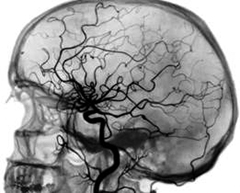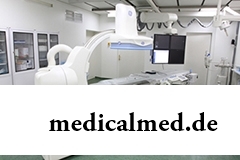





Angiography
Angiography: definition and appointment
The angiography is a X-ray inspection of vessels. 
This method differs from an ordinary research in the fact that enter a contrast agent into blood vessels – organic compound of iodine without which on the roentgenogram vessels will not be visible. Carry out an angiography after all-clinical inspection of the patient when by means of other method of a research to establish the diagnosis it was not possible. By means of an angiography of vessels it is possible to reveal defects in their development and damages (narrowings, aneurisms, a malformation), passability disturbance, and also defects and injuries of various internals, malignant and high-quality educations.
Kinds of an angiography of vessels
Depending on an objective allocate a brain angiography, arteriography, a venografiya, a heart angiography, a limfografiya, a fluorescent angiography.
The research of vessels of a brain is called a cerebral angiography – after introduction of contrast for a short period do several angiograms displaying venous, arterial, capillary phases of blood circulation. The angiography of a brain can be direct and indirect. Allocate a carotid and vertebralny direct cerebral angiography. Most often use a carotid method of a research – enter contrast into a neck, into a carotid artery. The Vertebralny angiography of a brain differs in the fact that compound of iodine is entered into a vertebral artery. At an indirect cerebral angiography approach a carotid or vertebral artery through other large vessel, for example through an artery on a hip: enter a long catheter and force contrast.
Arteriography - the diagnostic method of arteries allowing to reveal the new growths which were located near blood vessels, obstruction and narrowing of a gleam of arteries, various disturbances of a blood-groove.
Venografiya is appointed at diseases of veins on hands and legs. The research allows to see deeply located and superficial veins, their extent and localization in a picture, to diagnose thrombosis or a varicosity. In some cases the venografiya is appointed for assessment of pathologies of a heart rhythm, definition of heart failure.
More detailed information on a heart disease is given by a heart angiography – a research by means of which study cameras of heart and an artery. Carry out a heart angiography in the medical and diagnostic purposes. With its help it is possible to reveal various pathologies of vessels (thrombosis, narrowing or expansion, obstruction), to estimate blood pressure in heart and a pulmonary artery, sokratitelny ability of a myocardium.
Limfografiya is carried out for studying of a limfosistema and is appointed at malignant tumors of a uterus, ovaries. By means of this research it is possible to estimate degree of a disease and efficiency of the carried-out chemotherapy or operation on removal of lymph nodes.
 The fluorescent angiography is a method of a research of eye vessels and an eyeground at inflammations and dystrophic processes in a choroid and a retina, at a hypertension, a diabetic retinopathy, glaucoma. Besides by means of a fluorescent angiography study a boulevard conjunctiva and an iris at various diseases. As contrast use sodium salt of a flyuorestsein – 10% solution. Enter contrast into a vein on an elbow – 3-5ml, but before it reveal as it is transferred by the patient.
The fluorescent angiography is a method of a research of eye vessels and an eyeground at inflammations and dystrophic processes in a choroid and a retina, at a hypertension, a diabetic retinopathy, glaucoma. Besides by means of a fluorescent angiography study a boulevard conjunctiva and an iris at various diseases. As contrast use sodium salt of a flyuorestsein – 10% solution. Enter contrast into a vein on an elbow – 3-5ml, but before it reveal as it is transferred by the patient.
Contraindications to an angiography
It is impossible to carry out an angiography of vessels at acute infections and inflammatory diseases, in serious conditions, at mental diseases, serious renal, liver and heart failure, at an allergy to iodine.
The 74-year-old resident of Australia James Harrison became blood donor about 1000 times. It has a rare blood group which antibodies help to survive the newborn with a severe form of anemia. Thus, the Australian saved about two million children.

A little more than a century ago goat milk was a traditional food stuff of most of Russians. Unfortunately, today on tables...
Section: Articles about health
History of mankind contains several tens of epidemics whose emergence was compared by eyewitnesses and historians to doomsday. The most terrible of them claimed the lives of millions of people, having made even the whole people to the person of the earth. What they − the diseases striking terror? Daringly...
Section: Articles about health
The pancreas performs two functions in a human body: release of enzymes without which digestion of carbohydrates, fats and proteins, and a producing hormones is impossible. The most important of them - insulin, is the main participant of carbohydrate metabolism normalizing processes of education and utilization of glucose, the main energy source for an organism....
Section: Articles about health
Among a set of the perfumery and cosmetic goods which are released today the special group is made by the means containing anti-bacterial...
Section: Articles about health
According to data of World Health Organization, the cataract is diagnosed almost for 7% of the population of Earth. The statistics of incidence is considered not full as at an initial stage the illness, as a rule, does not cause to the person of special inconveniences, and many having got sick...
Section: Articles about health
Statistically, in Russia about 34% of citizens smoke. Most of consumers of tobacco has problems with health sooner or later. Not only smokers, but also their relatives suffer. Besides, cigarettes are expensive, and need of their acquisition goes a heavy burden on the budget of thousands of Russian families. Many people dream to refuse harmful tendency, but everyone manages to make it not: nicotine addiction is affectionate and to get rid of it not easy....
Section: Articles about health
The word "onikhokriptoz" is unfamiliar to most of people, meanwhile quite so physicians call very widespread problem: growing...
Section: Articles about health
Color of plants is caused by presence at them of certain chemical compounds. Let's talk about what is meant by various colors of vegetables and fruit and what properties they give them....
Section: Articles about health
With age in a human body harmful substances collect. We receive them with food and water, at inhalation of the contaminated air, reception of medicines, use of household chemicals and cosmetics. A considerable part of toxins accumulates in a liver which main function is continuous purification of blood. This body begins to knock as any got littered filter, and efficiency of its work decreases....
Section: Articles about health
The trophic ulcer is not an independent disease. This heavy complication arising owing to a thermal injury (a burn...
Section: Articles about health
The next flu epidemic leads to the next panic, from year to year we give in on these manipulations: professionally alarming voice of the announcer in news, reports with calculation of the died patients, an interview with people in white dressing gowns and advertizing of anti-influenza means ра...
Section: Articles about health
The naturopathy sometimes moves as the new direction of medicine, something like fashionable hobby, and there is nothing farther from the truth. This most ancient direction, the word "naturopathy" is translated as "treatment by the nature", and, no doubt, treatment by natural gifts was the first and only, available to the person in ancient times. Despite modern achievements of medicine, the naturopathy remains urgent and today, anyway the person - a part of the nature, and природн...
Section: Articles about health
On health of the person physicians know about salutary action of animals long ago. About 7 thousand years ago great Hippocrates рекоменд...
Section: Articles about health
Visit of doctors – business not the most pleasant, and many people do not hurry to undergo necessary planned inspections. Such behavior is extremely thoughtless and improvident. Our health is necessary not only to us: wellbeing of darlings, children, grandsons and престар...
Section: Articles about health
The phenomenon of the panic attack is known long ago, but the reasons of its emergence still are up to the end not found out. It is established that more than 30% of people at least once in life become the victims of very unpleasant phenomenon: without everyones on that the reasons they have a feeling of horror which is followed by a cardiopalmus, a shiver and the fever or feeling of sudden heat increased by sweating, breath constraint, dizziness, nausea....
Section: Articles about health
On the head of the person about one million hair follicles, or as they are called still, hair bulbs are located. At the moment he is born...
Section: Articles about health
The phenomenon of improvement of a condition of the patients at administration of drugs who are not containing active agents, so-called effect of placebo is known long ago. At the end of the 18th century the American doctor Perkins began to treat people the "miracle" sticks made of a spl...
Section: Articles about health
Condition of lips (their morbidity, outward) – one of indicators of health of the person. The peeling, dryness, pallor, and also cracks in corners of a mouth can be not only the cosmetic shortcoming which arose owing to physical damages and weather conditions but also the satellite of some diseases and disturbances in an organism needing treatment. Let's consider 10 possible reasons of emergence of angular cracks (perleches) in corners of a mouth and ways of their elimination....
Section: Articles about health
Bathing in broths of medical flowers and plants (phytobathtub) was eurysynusic since Cleopatra who is a good judge of everything...
Section: Articles about health
The main role in development of a peptic ulcer of a stomach and duodenum the bacterium Helikobakter plays pilor. Activity and the strengthened reproduction of this microorganism lead to weakening of protection of mucous membranes and their erosive damage. Manifestations not...
Section: Articles about health
Almost each of us during life faced dissatisfaction with own body. At such moments, as a rule, we begin to shame ourselves, urgently we go on the most rigid diet promising minus of 10 kg in a week, or we exhaust ourselves in the gym to almost death. As a rule, similar attempts come to an end with a campaign to the refrigerator for jamming of the next stress. Further history repeats itself with individual frequency....
Section: Articles about health
Today about 30 diseases, sexually transmitted are known. To wide circulation of these illnesses extremely with...
Section: Articles about health
Partial and the more so full loss of hearing significantly reduces quality of life. Difficulties with communication lead to loneliness and isolation. The person who badly hears experiences difficulties with social and professional implementation, quite often has problems in...
Section: Articles about health
The metabolism at each person proceeds in own way. However between the speed of this process and disposal of excess weight after all all have a dependence. Unfortunately, the people inclined to try on itself numerous "miracle" diets, not always consider this circumstance and with the most resolute intentions begin to eat so that artificially slow down the metabolism instead of to accelerate it. Except quite clear disappointment, incorrectly picked up systems...
Section: Articles about health
The state of health of the person depends on many factors. One of the most important is the constant but which is not exhausting, motive...
Section: Articles about health
The mankind knows that some toxins at intake in the minimum quantities have therapeutic effect from an extreme antiquity. Many substances recognized poisonous are applied in the medical purposes also today, being the main deystvuyushch...
Section: Articles about health
Hemorrhoids – extremely widespread disease. Periodically arising inflammations and bleeding of hemorrhoidal nodes cause serious discomfort to nearly fifteen percent of adults. Meanwhile, having a clear idea of the reasons of an exacerbation of an illness and following rules of precaution, it is possible to reduce substantially sharpness of unpleasant feelings and to reduce progressing of a disease....
Section: Articles about health
